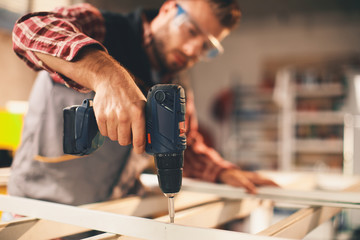Handyman completes various repairs and maintenance tasks in commercial and residential settings. Handyman Naperville IL works for service companies, construction firms, or as a self-employed professional.
 While there’s no required education to become a handyman, vocational schools and community college courses in specific crafts can be useful. Some handymen even take up apprenticeships.
While there’s no required education to become a handyman, vocational schools and community college courses in specific crafts can be useful. Some handymen even take up apprenticeships.
A handyman uses fish tape to guide wiring through a finished wall, conduit, or other space where drilling would be hard. It’s like a wire “guide string” and can help prevent tangled, snagged or damaged wiring. It also saves time by eliminating the need to make multiple holes in a finished wall. The fish tape is available in a variety of lengths and materials, depending on the needs of the job.
Electricians and information transport systems installers are two professionals that frequently use this tool. It’s also used by homeowners and some general contractors, especially when working with energized circuits or in wet environments. The metal fish tape is often a conductor of electricity, so it’s important to turn off all electrical circuits before using it. Non-conductive fiberglass versions are also available to help avoid injuries and damage to sensitive electronic equipment.
Typically, the fish tape has hooks on either end to attach to wires. After feeding it to the desired location in a finished wall or conduit, a hook on one end is attached to the wiring, and the other end is pulled back, slowly reeling the tape to bring it through the wall or conduit. This allows the worker to keep their hands free while pulling the wires through.
The steel fish tape is a common type of tool that can be found at most hardware stores. It has a high tensile strength and can handle a lot of push and pull. It can be purchased in various lengths, but it’s usually best to get a longer version for most jobs. It’s also a good idea to get one that has laser-etched markings on its body for easy identification of wire length.
Some fish tapes come with a case that keeps it coiled and protected when not in use. Others have a plastic reel that can be manipulated by hand to guide it in the direction needed. The case is an option that can save storage space, but it’s not necessary for most jobs. Some also feature a winder to decrease the effort it takes to pay out the tape and a handle for easy handling.
Electrical tape may look mundane, but this pressure-sensitive adhesive is crucial for some connections. It keeps current from flowing between wires, preventing short circuits and fires. It also insulates wire connections that are nearly touching flammable materials, like wood wall studs.
The right electrical tape isn’t the same as ordinary taping supplies, though. This specialty tape needs to be able to withstand heat and other conditions that could cause it to degrade over time. The best electrical tape for a handyman will have an insulating core that’s made from materials like polyethylene and vinyl. This insulation helps protect the core from moisture, abrasion, and corrosion. It should also be flame-retardant and resistant to high temperatures.
Choosing the right electrical tape depends on the type of projects a handyman does. Some options for common electrical applications include traditional vinyl tape, which is economical and works well in most situations. Polyvinyl chloride, or PVC, tape is ideal for outdoor use because it resists cold temperatures and helps prevent metal corrosion. This type of tape can help a handyman seal and insulate wires when working outdoors, or it can be used to make minor repairs to exposed wiring.
Other options for electrical tape include specialized models that can handle high voltage or abrasion resistance. When working with high voltage, a handyman must ensure that all wires are properly insulated and not touching each other. This prevents a short circuit, which can be deadly and expensive to repair.
For abrasion resistance, look for options that feature an abrasion-resistant coating or mastic tape. This specialized material is thicker and more durable than standard vinyl tape and is often available in higher-mil thicknesses to better resist damage or abrasion.
When working with high-voltage wires, a handyman should choose an option that can withstand extremely high temperatures. A model with a UL listing or CSA approval is likely to perform well in these circumstances. This certification is an indication that the product has been independently tested to meet certain safety standards. For example, a UL-rated tape will be able to withstand temperatures of up to 212 degrees Fahrenheit.
A circular saw is a powerful tool that can be used to cut wood, metals, and plastics. This type of power tool is typically corded, but you can also find cordless models. The design of a circular saw allows the user to work from various angles. This allows for a more precise cut in difficult-to-reach areas, which is ideal for handymen who work on construction projects. There are a number of factors to consider when choosing the best circular saw, including the size of the blade and the comfort level of the handle.
You should start by determining how and why you’ll use a circular saw. This will help you decide what type of blade to get and how to set up the machine. It’s also important to consider safety precautions when using a circular saw, especially when it comes to eye and hearing protection.
Before you start cutting, make sure the saw is turned off and the trigger lock switch is activated. This will prevent the saw from accidentally turning on while you’re using it. If you’re using a cordless model, make sure the battery is fully charged. Also, make sure the guard is in place to keep the blade covered while not in use. Once you’re ready to begin cutting, loosen the bevel adjustment knob to change the angle of the saw’s shoe and blade.
The depth adjustment knob can also be loosened to adjust the saw’s cutting depth. You’ll want to be careful when making these adjustments, as you could cause damage if the blade is set too deep. When cutting wood, the ideal blade is a high-carbon steel or high-speed steel one. For harder lumber like plywood, a tough carbide-tipped blade will be more effective.
To ensure a straight cut, you can use a rip attachment or clamp a guide in place. A circular saw jig is another option for making straight cuts. It slots into the base plate of the saw and has reference points to keep you on track. Some models of circular saws also have built-in dust blowers to clear away any sawdust that might interfere with your vision and limit your view of the blade.
A miter saw is a power tool that uses a pivoting arm and spinning blade to quickly and accurately cut wood, plywood, MDF, plastic, and in some cases, metal. It is a handy tool to have for any home improvement project and can help you tackle many different tasks around the house. However, it is important to know how to properly use a miter saw so that you can avoid any accidents or mishaps while using it.
Before you start using your miter saw, read the manual and become familiar with the different parts of it. Make sure that the safety trigger, bevel adjustments, and other handles are locked in place before you plug it in and activate it. Also, before starting any cuts, support the workpiece firmly with a hold-down clamp and place it on the saw table. Then, loosen the handle on the miter gauge at the front of the base and depress the lock handle to adjust the angle. After adjusting the miter gauge, lower the blade and make sure that the inside of the lowest tooth lines up with your cutline. If necessary, loosen the lock handle to further adjust the angle of the blade.
Generally, a powered miter saw can make three types of cuts: crosscuts, miters, and bevels. A crosscut cut is a straight line across the wood, while a miter cut is an angled cut used to seat two corners of wood together. A bevel cut is a sloped angle across the wood, and a compound miter saw can combine both a miter and a bevel cut.
When choosing a miter saw, look at its cut type, blade length, power level, and dust collection system to ensure that it matches your carpentry needs. You may also want to consider the amount of space you have available in your workshop and whether you need a portable option.
When selecting a miter saw, choose one that is designed to accommodate a wide range of materials. The most common types are maple and oak, but it is possible to use a miter saw with other woods if the blade is sharp and the cutting area is clean. Always refer to the manufacturer’s instructions for more information on fine-tuning the blade alignment. Always wear a pair of protective gloves while operating the saw and keep your hands away from the blade to prevent injury.
